sas a00-240 practice test
SAS Statistical Business Analysis Using SAS 9: Regression and Modeling
Question 1
Refer to the ROC curve: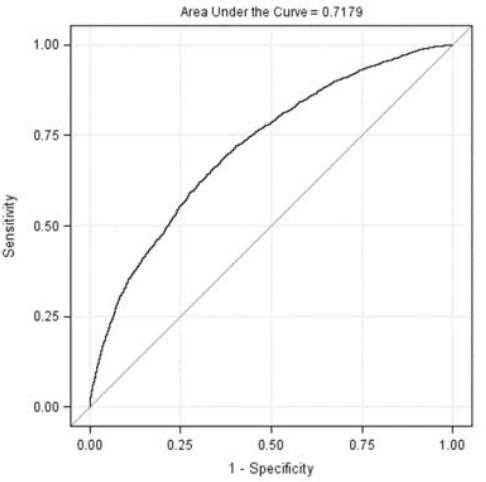
As you move along the curve, what changes?
- A. The priors in the population
- B. The true negative rate in the population
- C. The proportion of events in the training data
- D. The probability cutoff for scoring
Answer:
D
Question 2
When mean imputation is performed on data after the data is partitioned for honest assessment,
what is the most appropriate method for handling the mean imputation?
- A. The sample means from the validation data set are applied to the training and test data sets.
- B. The sample means from the training data set are applied to the validation and test data sets.
- C. The sample means from the test data set are applied to the training and validation data sets.
- D. The sample means from each partition of the data are applied to their own partition.
Answer:
B
Question 3
An analyst generates a model using the LOGISTIC procedure. They are now interested in getting the
sensitivity and specificity statistics on a validation data set for a variety of cutoff values.
Which statement and option combination will generate these statistics?
- A. Score data=valid1 out=roc;
- B. Score data=valid1 outroc=roc;
- C. mode1 resp(event= '1') = gender region/outroc=roc;
- D. mode1 resp(event"1") = gender region/ out=roc;
Answer:
B
Question 4
In partitioning data for model assessment, which sampling methods are acceptable? (Choose two.)
- A. Simple random sampling without replacement
- B. Simple random sampling with replacement
- C. Stratified random sampling without replacement
- D. Sequential random sampling with replacement
Answer:
A,C
Question 5
Which SAS program will divide the original data set into 60% training and 40% validation data sets,
stratified by county?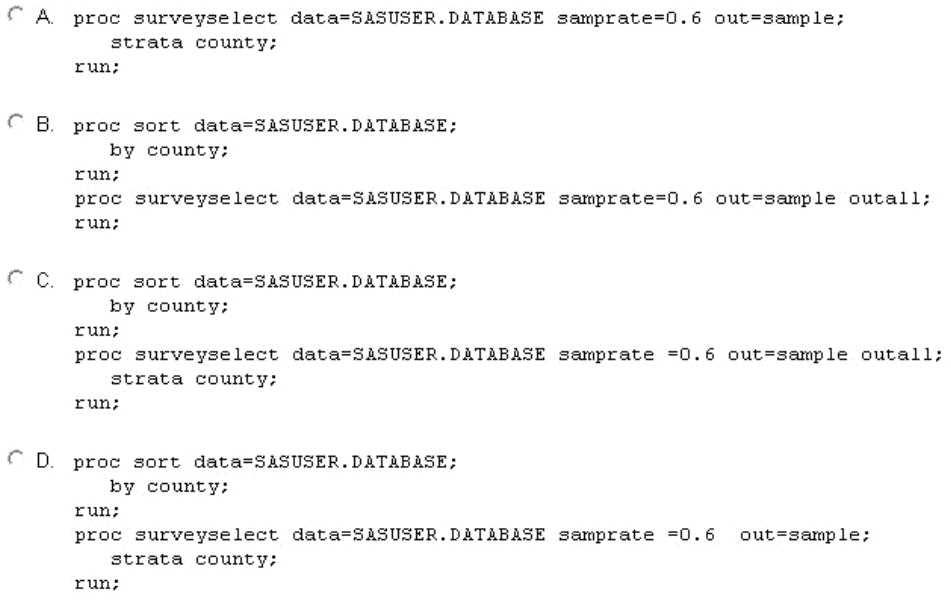
- A. Option A
- B. Option B
- C. Option C
- D. Option D
Answer:
C
Question 6
Refer to the lift chart: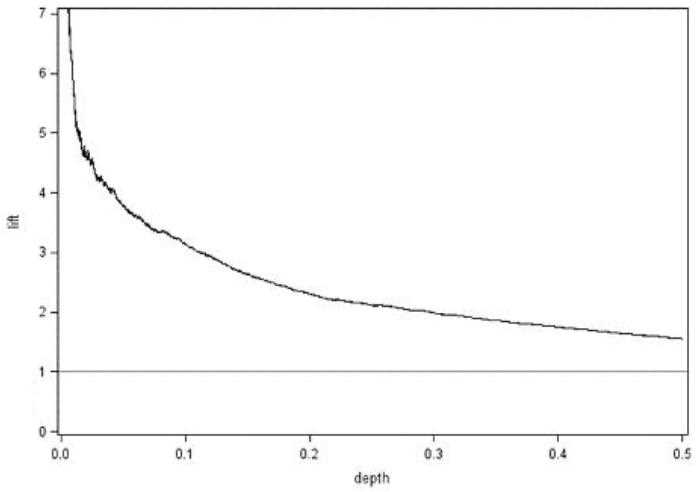
At a depth of 0.1, Lift = 3.14. What does this mean?
- A. Selecting the top 10% of the population scored by the model should result in 3.14 times more events than a random draw of 10%.
- B. Selecting the observations with a response probability of at least 10% should result in 3.14 times more events than a random draw of 10%.
- C. Selecting the top 10% of the population scored by the model should result in 3.14 times greater accuracy than a random draw of 10%.
- D. Selecting the observations with a response probability of at least 10% should result in 3.14 times greater accuracy than a random draw of 10%.
Answer:
A
Question 7
Refer to the lift chart:
What does the reference line at lift = 1 corresponds to?
- A. The predicted lift for the best 50% of validation data cases
- B. The predicted lift if the entire population is scored as event cases
- C. The predicted lift if none of the population are scored as event cases
- D. The predicted lift if 50% of the population are randomly scored as event cases
Answer:
B
Question 8
Suppose training data are oversampled in the event group to make the number of events and non-
events roughly equal. A logistic regression is run and the probabilities are output to a data set NEW
and given the variable name PE. A decision rule considered is, "Classify data as an event if probability
is greater than 0.5." Also the data set NEW contains a variable TG that indicates whether there is an
event (1=Event, 0= No event).
The following SAS program was used.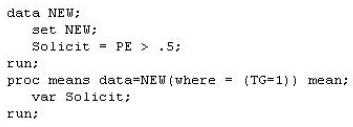
What does this program calculate?
- A. Depth
- B. Sensitivity
- C. Specificity
- D. Positive predictive value
Answer:
B
Question 9
Refer to the exhibit: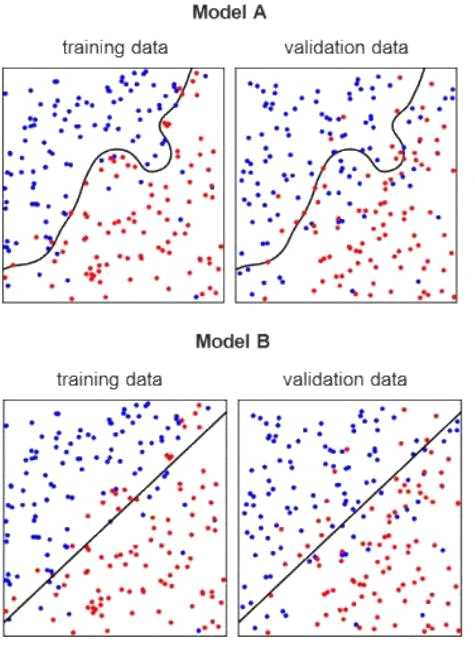
The plots represent two models, A and B, being fit to the same two data sets, training and validation.
Model A is 90.5% accurate at distinguishing blue from red on the training data and 75.5% accurate at
doing the same on validation dat
a. Model B is 83% accurate at distinguishing blue from red on the training data and 78.3% accurate at
doing the same on the validation data.
Which of the two models should be selected and why?
- A. Model A. It is more complex with a higher accuracy than model B on training data.
- B. Model A. It performs better on the boundary for the training data.
- C. Model B. It is more complex with a higher accuracy than model A on validation data.
- D. Model B. It is simpler with a higher accuracy than model A on validation data.
Answer:
D
Question 10
Assume a $10 cost for soliciting a non-responder and a $200 profit for soliciting a responder. The
logistic regression model gives a probability score named P_R on a SAS data set called VALID. The
VALID data set contains the responder variable Pinch, a 1/0 variable coded as 1 for responder.
Customers will be solicited when their probability score is more than 0.05.
Which SAS program computes the profit for each customer in the data set VALID?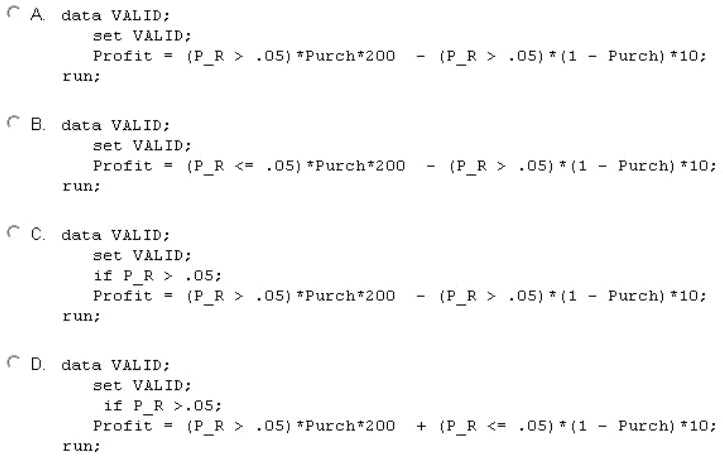
- A. Option A
- B. Option B
- C. Option C
- D. Option D
Answer:
A
Question 11
In order to perform honest assessment on a predictive model, what is an acceptable division
between training, validation, and testing data?
- A. Training: 50% Validation: 0% Testing: 50%
- B. Training: 100% Validation: 0% Testing: 0%
- C. Training: 0% Validation: 100% Testing: 0%
- D. Training: 50% Validation: 50% Testing: 0%
Answer:
D
Question 12
Refer to the exhibit: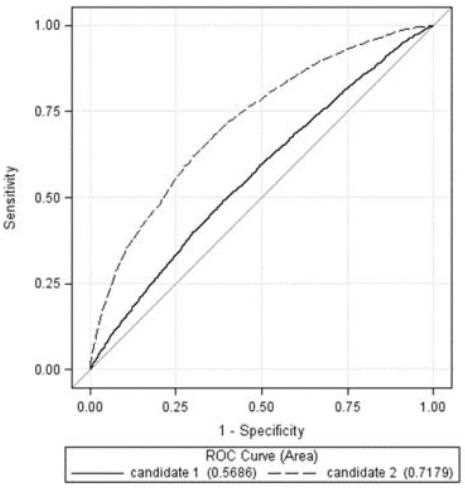
Based upon the comparative ROC plot for two competing models, which is the champion model and
why?
- A. Candidate 1, because the area outside the curve is greater
- B. Candidate 2, because the area under the curve is greater
- C. Candidate 1, because it is closer to the diagonal reference curve
- D. Candidate 2, because it shows less over fit than Candidate 1
Answer:
B
Question 13
A marketing campaign will send brochures describing an expensive product to a set of customers.
The cost for mailing and production per customer is $50. The company makes $500 revenue for each
sale.
What is the profit matrix for a typical person in the population?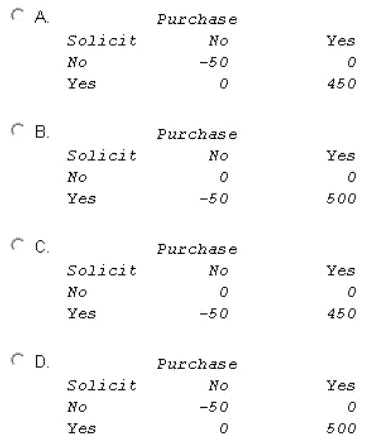
- A. Option A
- B. Option B
- C. Option C
- D. Option D
Answer:
C
Question 14
A confusion matrix is created for data that were oversampled due to a rare target.
What values are not affected by this oversampling?
- A. Sensitivity and PV+
- B. Specificity and PV-
- C. PV+ and PV-
- D. Sensitivity and Specificity
Answer:
D
Question 15
This question will ask you to provide missing code segments.
A logistic regression model was fit on a data set where 40% of the outcomes were events (TARGET=1)
and 60% were non-events (TARGET=0). The analyst knows that the population where the model will
be deployed has 5% events and 95% non-events. The analyst also knows that the company's profit
margin for correctly targeted events is nine times higher than the company's loss for incorrectly
targeted non-event.
Given the following SAS program:
What X and Y values should be added to the program to correctly score the data?
- A. X=40, Y=10
- B. X=.05, Y=10
- C. X=.05, Y=.40
- D. X=.10, Y=05
Answer:
B